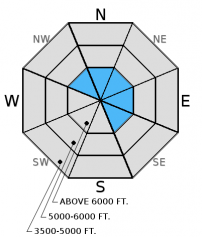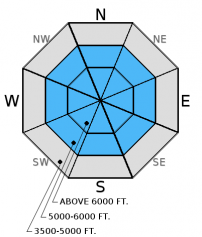| Wednesday | Wednesday Night | Thursday | |
|---|---|---|---|
| Cloud Cover: | Snow | Snow ending. | Warming trend. |
| Temperatures: | 28-34 deg. F. | 12-22 deg. F. | 29-39 deg. F. |
| Wind Direction: | SW | SW | S |
| Wind Speed: | 6-10 | 6-9 | 6-10 gusts 24 |
| Snowfall: | 2-5 in. | 0-1 in. | 0 in. |
| Snow Line: |
Whitefish Range
Swan Range
Flathead Range and Glacier National Park
How to read the forecast
Today, the avalanche danger is CONSIDERABLE above 5000'. Substantial recent storm snow, along with new snow overnight, has fallen on a variety of weak layers and crusts. Cautious route-finding, careful snowpack evaluation, and conservative decision making are essential. Human triggered avalanches are still likely on steep slopes today. The avalanche danger below 5000' is MODERATE.

3. Considerable
?
Above 6500 ft.
3. Considerable
?
5000-6500 ft.
2. Moderate
?
3500-5000 ft.
- 1. Low
- 2. Moderate
- 3. Considerable
- 4. High
- 5. Extreme
-
Type ?
-
Aspect/Elevation ?

-
Likelihood ?CertainVery LikelyLikelyPossible
 Unlikely
Unlikely -
Size ?HistoricVery LargeLargeSmall

Yesterday, active wind loading was observed in southern Glacier Park and the Flathead Range onto leeward slopes and cross-loaded slopes. We assume favored locations in the Swan and Whitefish Ranges also saw similar activity. Isolated cracking, along with shooting cracks, was noted in the freshly developed wind slabs. Wind speeds diminished overnight but with plenty of fresh surface snow available for transport I am confident that wind loading occured overnight and will continue through the day at upper elevations. Fresh wind slabs have formed on top of a variety of surfaces including sun crusts, freezing rain crusts, buried surface hoar and currently onto recent storm snow. Look for smooth, rounded features on the slope especially on steep convex rollovers, on leeward sides of ridges and cross-loaded gullies.
-
Type ?
-
Aspect/Elevation ?

-
Likelihood ?CertainVery LikelyLikelyPossible
 Unlikely
Unlikely -
Size ?HistoricVery LargeLargeSmall

Recent storm snow was deposited on a variety of weak layers and crusts. There is a lot of variability across the advisory area with this problem that warrants careful snowpack evaluation and cautious route-finding. Surface hoar and weak faceted snow were observed in all ranges but you won't find them on all slopes. These weak layers are now 1.5 to 4 feet deep after the recent storm. Surface hoar is notorious for propagating long distances across a slope, around corners, and through the trees. Given the tricky distribution of these persistent slabs it would be wise to avoid steep, open slopes and convexities. Look for obvious signs of instability like recent avalanche activity, shooting cracks, and whumpfing.
-
Type ?
-
Aspect/Elevation ?

-
Likelihood ?CertainVery LikelyLikelyPossible
 Unlikely
Unlikely -
Size ?HistoricVery LargeLargeSmall

In the Flathead Range a new thin rain crust was deposited on top of weak cohesionless snow January 17th. We do not yet know the distribution of this layer across our advisory area. Yesterday, we noted 6-8 inches of new snow on top of this crust and observed easy failure in our stability tests in the weak snow below the crust. Today's storm will deposit additional snow onto this crust which will further stress this weak interface. To determine if this crust is present where you are skiing or riding is simple and may not even require a shovel. Brush away the top foot or so of new snow since Sunday and look for an obvious thin rain crust. It is either there or it's not!
LOOSE AVALANCHES: Over the past few days warm temperatures at low and mid elevations created a wet loose avlanche problem in the surface snow. With warm moist snow currently falling across our advisory area the possibility of loose avalanches will rise again today. Watch for signs of increasing wet loose avalanche danger if conditions remain clear today and temperatures rise above freezing. Early signs of instability include surface snow that becomes moist and roller balls forming on steep slopes and cutbanks. Loose, wet avalanches can knock you off your feet, or sled, and even entrain enough snow to bury you. Use extra caution when traveling near terrain traps like narrow gullies, steep treed areas, and cliffs.
Yesterday, Erich and I travelled to Tunnel Ridge in the Flathead Range. We observed active wind loading throughout the day onto north and east aspects. On a north aspect we found a NEW rain crust that was deposited on January 17 and buried beneath 6 inches of surface snow.. Stability tests resulted in propagation with easy force below this crust and propagation with hard force below the January 12 rain crust (observation, video, photo). BNSF avalanche safety noted active windloading on east and northeast aspects and windslab conditions on northeast - south aspects. They also observed shooting cracks and were able to intentionally trigger small soft slabs on leeward slopes.
On Sunday, Guy and his partner were in the Canyon Creek and Werner Peak area of the southern Whitefish Range. On a south aspect of Werner Peak they found a shallow snowpack (115 centimeters). Stability tests revealed propagation on top of the January 12 rain crust with moderate force. On a north aspect, stability tests required hard force to initiate propagation in weak faceted snow beneath the January 12 rain crust (observation). BNSF snow safety reported active wind loading at upper elevations in John F Stevens Canyon.
Sunday, I was in Canyon Creek in the southern Whitefish Range with a motorized avalanche class and saw small sluffs and roller balls forming on steep slopes late in the day. Skiers in Spider Bowl in the Swan Range noted that the surface snow became heavy as the day progressed and there was a thin crust forming up to 8000 feet. Skiers in Chicken Creek in the northern Whitefish Range found the January 12 freezing rain crust to be reactive in stability tests (observation). Skiers in the Flathead Range returned to the area that they were on the previous day and found similar stability test results, but the snow had become more dense (observation).
Saturday, Todd and Guy were in Noisy Basin in the Swan Range where they saw widespread recent avalanche activity (photo). Several of the the avalanches were relatively shallow and occured early in the recent storm cycle, while others failed on the weak snow formed in early Jan. and were 3-3.5 feet deep (observation).
Skiers in the Flathead Range on Saturday also noted recent avalanche activity and found instability within storm snow and on the Jan. 12 freezing rain crust (observation). Skiers on Ghoulie Point in the southern Whitefish Range found a freezing rain crust buried 2 feet deep in the snowpack that was minimally reactive in stability testing. A seperate party of skiers on Skookoleel Face, also in the southern Whitefish Range found the new snow/old snow interface to be reactive in stability testing (ECTP 16 Q2 35cm from the surface). Snowmobilers in the six-mile area in the Swan Range reported recent natural activity. They estimated the width at 100 feet with a 2-3 foot crown.
On Friday a party of skiers triggered multiple avalanches that were reported as 16 inches deep. These avalanches occured on the south side of Ghoulies outside of the ski area boundary in the southern Whitefish Range. One skier was caught and carried through the trees, and luckily only sustained minor injuries. BNSF Avalanche Safety reported a natural avalanche in the Java Creek drainage in the Flathead Range (photo). Another natural avalanche was observed by a group of snowmobilers riding on Doris Ridge in the Swan Range.
On Friday Todd was in the Lost Johnny and Doris Creek drainages in the Swan Range and found up to 2.5 feet of recent, unconsolidated snow at low elevation. Though the rain that came with the arrival of the system began to decompose buried surface in the mid-elevation band, it was still present in the snowpack.
Thursday, Erich easily triggered a storm slab (12-16 inches deep and 50 feet wide) from the top of a flat, safe ridge just east and outside the boundary of Whitefish Mountain Resort (video, photo). The slab failed on the freezing rain crust that formed Wednesday (1/12/2016). Also, on Thursday in John F. Stevens Canyon in southern Glacier NP, BNSF Avalanche Safety observed 3 natural wind slab avalanches and intentionally triggered another on a test slope (photo, observation). The deepest part of the slab was 50 inches deep and failed on buried surface hoar.
Thanks to everyone for submitting observations. They are extremely useful for everyone.
Visit our Observations page and our You Tube channel for more observations from the entire season.
Please let us know what you are seeing out there. Your observations are important and valued.
HOW TO SUBMIT OBSERVATIONS:
Email: [email protected]
Call and leave a message: 406.387.3821
You can also submit quick observations via text: 406.241.4571 (FAC mobile)
OR
Submit Snowpack Observations: http://www.flatheadavalanche.org/node/add/snowobs
Submit Avalanche Observations: http://www.flatheadavalanche.org/node/add/avyobs
Yesterday brought partly cloudy skies, very light precipitation and relatively warm air temperatures. Currently, mountain temperatures range from 24º-30º F and winds are light with moderate gusts out of the southwest. Precipitation arrived to our area early this morning and we can expect moderate snow to continue through the day. Today, temperatures at low and mid elevations are expected to hover around freezing with upper elevations in the mid to upper 20s. Winds will continue out of south-southwest at 5-15 mph with gusts in the 20s. The Swan Range is again favored with this storm although all ranges should see beneficial snowfall.
| 0600 temperature: | 24-30 deg. F. |
| Max. temperature in the last 24 hours: | 27-32 deg. F. |
| Average wind direction during the last 24 hours: | SW |
| Average wind speed during the last 24 hours: | 5-10 mph |
| Maximum wind gust in the last 24 hours: | 10-20 mph |
| New snowfall in the last 24 hours: | 1-3 inches |
| Total snow depth: | 55-80 inches |
This advisory applies only to backcountry areas outside established ski area boundaries. This advisory describes general avalanche conditions and local variations always occur. This advisory expires at midnight on the posted day unless otherwise noted. The information in this advisory is provided by the USDA Forest Service who is solely responsible for its content.








































